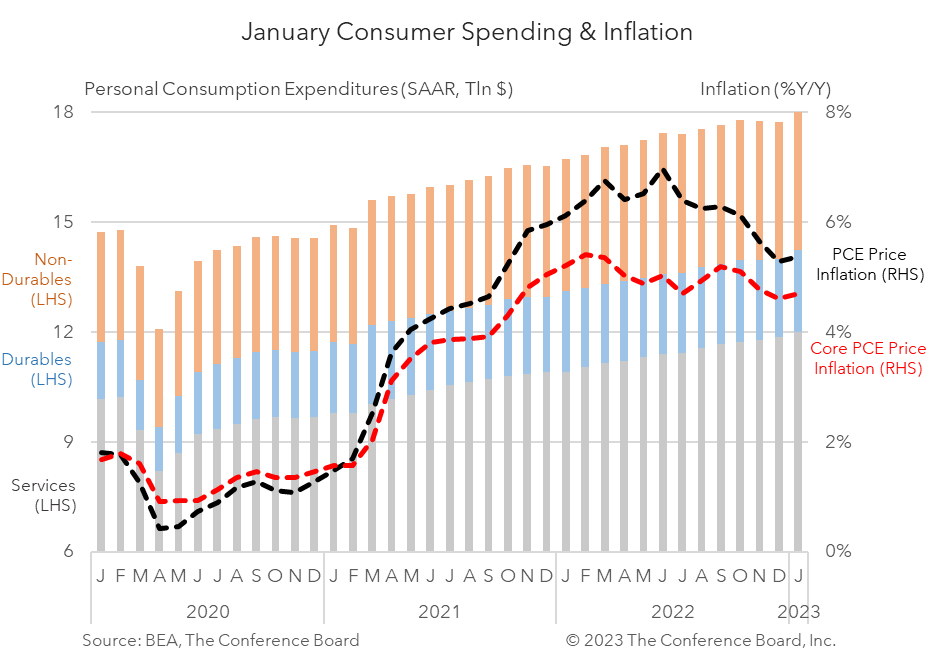-
Email
Linkedin
Facebook
Twitter
Copy Link

Loading...
Following spikes in January Retail Sales and CPI data earlier this month, today’s Personal Income & Outlays data also rebounded. Real consumer spending rose by 1.1 percent month-over-month (m/m) following two consecutive months of contraction. Meanwhile, inflation metrics also intensified following months of cooling. Headline PCE price inflation rose to 5.4 percent from a year earlier and jumped to 0.6 percent in month-over-month terms. Core PCE price inflation also spiked. Personal incomes rose by 0.6 percent from the month prior, but were roughly flat in real terms. Collectively, this report is consistent with other January data that also show a bump in economic activity. However, last month’s favorable weather was a factor that may have influenced consumer behavior. Regardless, the Fed will see these developments as counterproductive and may elect to raise interest rates higher than previous guidance suggested. We are increasing our Fed Funds forecast from two additional 25 basis point hikes to three additional 25 basis point hikes over the coming months. We do not expect the Fed to pivot until 2024. Headline PCE price inflation rose from 5.3 to 5.4 percent year-over-year (y/y) in January and core PCE price inflation (which excludes food and energy) rose from 4.6 to 4.7 percent y/y. On a month-over-month basis, both headline and core PCE inflation rose by 0.6 percent. Services continued to be a driver of overall inflation for the month, but prices for both durable and non-durable goods also spiked following several months of contraction. Overall personal income rose 0.6 percent m/m (in nominal terms) in January, vs. 0.3 m/m percent in December. However, the spike in month-over-month inflation kept the real growth rate roughly flat. Meanwhile savings rates rose to 4.7 percent of disposable personal income. Personal consumption expenditure rose by 1.8 percent m/m (in nominal terms) in January, vs. -0.1 m/m percent in December. Spending on services rose by 1.3 percent m/m while spending on goods rose 2.8 percent m/m. However, after accounting for inflation, real consumer spending was 1.1 percent m/m in January with spending on goods rising 2.2 percent m/m and spending of services rising 0.6 percent m/m. Note: nominal means non-inflation adjusted, while real means inflation adjusted.Inflation
Incomes
Spending

Retail Sales Show Consumers Stock Up ahead of Tariffs
April 16, 2025
US Seeks Shipbuilding Revival, Muting of China Dominance
April 14, 2025
March CPI May Hint at Consumer Pullback as Tariffs Rise
April 10, 2025
The US-China Trade War Escalates
April 09, 2025
Reciprocal Tariffs Will Weaken US and Global Economies
April 03, 2025
Charts
Preliminary PMI indices show no change in weak DM growth momentum in November
LEARN MORECharts
Members of The Conference Board can access all underlying data of the Job Loss Risk Index by Industry in this Excel workbook.
LEARN MORECharts
While a US recession appears to be imminent, it will not look like any other in recent history.
LEARN MORECharts
CEOs’ views of current and future economic conditions remain pessimistic as they prepare for near-inevitable US and EU recessions.
LEARN MORECharts
The US economy appears to be on the precipice of recession.
LEARN MORECharts
Measure of CEO Confidence declined for the fifth consecutive quarter in Q3 2022 and has hit lows not seen since the start of the COVID-19 pandemic in 2020.
LEARN MOREPRESS RELEASE
US Leading Economic Index® (LEI) Fell in March
April 18, 2024
PRESS RELEASE
US Consumer Confidence Little Changed in March
March 26, 2024
PRESS RELEASE
US Leading Economic Index® (LEI) Inched Up in February
March 21, 2024
PRESS RELEASE
US Consumer Confidence Retreated in February
February 27, 2024
PRESS RELEASE
US Leading Economic Index® (LEI) Fell Further in January
February 20, 2024
PRESS RELEASE
CEO Confidence Improved in Q1 2024
February 08, 2024
